The SNES Classic Mk. II: Episode XI: Cecil B. DeMup
By Mento 0 Comments
The SNES Classic had a sterling assortment of games from Nintendo's 16-bit star console, but it's hardly all that system has to offer a modern audience. In each installment of this fortnightly feature, I judge two games for their suitability for a Classic successor based on four criteria, with the ultimate goal of assembling another collection of 25 SNES games that not only shine as brightly as those in the first SNES Classic, but have equally stood the test of time. The rules, list of games considered so far, and links to previous episodes can all be found at The SNES Classic Mk II Intro and Contents.
Episode XI: Cecil B. DeMup
The Candidate: Almanic/Technos's Shin Nekketsu Kouha Kunio-kun: Kunio-tachi no Banka
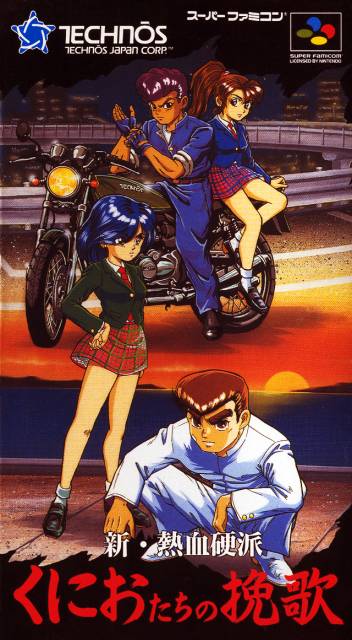
I've been thinking about Sega's Yakuza a lot lately, both because it was recently announced that Sega would be punching up the three PS3-era games (Yakuzas 3-5) with HD remasters, but also because Summer is usually the time when I carve out a month to spend with Kiryu and friends. When considering the game's roots, most would reductively class the game as Japan's take on the Grand Theft Auto open-world games, citing their shared link of a seedy criminal underworld and the legendary badass figure the protagonist cuts across same. I think if you go deeper, while perhaps staying in Japan's backyard, a more likely antecedent would be Technos's River City Ransom: the most famous entry in Technos's busiest franchise, Kunio-kun.
While the Kunio-kun games are generally set in high school and follow the eponymous delinquent Kunio of Nekketsu ("Hot-Blooded") HS (dressed in white) and his rival/ally Riki of Hanazono HS (dressed in blue), they occasionally start drawing in bosozoku gangs and yakuza as the stakes get higher beyond simple battles for school dominance. However, most Kunio-kun games don't really feature much of a plot: their similarity to the Yakuza franchise is more mechanical in nature. The way you can earn money from fights in River City Ransom and then choose to spend that money either on food to restore your health, consumable weapons for an extra edge, or on new techniques to grow stronger is a staple of the Yakuza series as well. Conversely, however, the wordy Shin Nekketsu Kouha Kunio-kun: Kunio-tachi no Banka (which translates, roughly, to "New Hot-Blooded Tough Guy Kunio: The Elegy of Kunio and Friends", or perhaps "An Elegy for Kunio and Friends") is an entry in the Kunio-kun series that is far more like Yakuza narratively than it is mechanically.
Kunio-tachi no Banka starts with a dramatic cutscene of a motorcycle hit-and-run, the culprit being a dead ringer for Kunio. A witness of the crash has Kunio and Riki (who was also on the bike) put away in prison, which they have to escape before they can clear their names. The story, and game, proceeds much like a standard brawler would: every level, and every boss, gets you one step closer to the mastermind. However, Kunio-tachi no Banka breaks up each sequence with a considerable amount of chatter between Kunio, Riki, their girlfriends (and eventual playable characters) Misako and Kyouko, their nerdy non-combatant friends Hiroshi and Mamoru, and the various villains of the game, that range from opportunistic delinquents who are quick to step into the shoes Kunio and Riki left behind, to the hoodlums and crime bosses calling the shots. There's a decent enough variation of enemies in the game, though they don't employ RCR's entertaining "Guess Who?" indenti-kit technique of creating dozens of marginally different foes by slightly changing their facial features and hair, and it frequently forces you to rely on different tactics to bring them down.
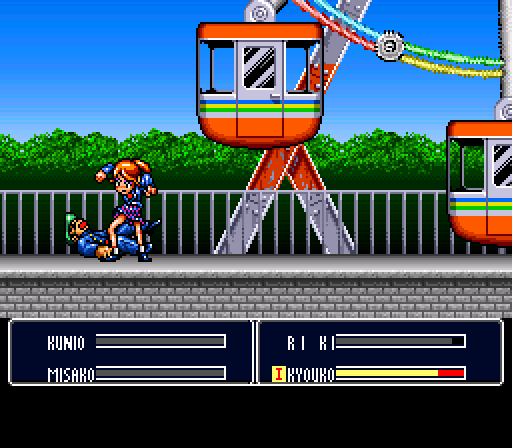
Speaking of which, Kunio-tachi no Banka operates on a vaguely fighter-like brawler construct that Technos had earlier developed with their Double Dragon series. As well as the standard punches and kicks, either of which can be comboed into a strong finisher, the player also has dedicated buttons for back attacks, jumps, and guards. They can dash with a double-tap in either direction, which has a charge finisher by hitting punch and kick simultaneously, and each of the four characters have a different duo of specials; these are activated by holding guard and either punch or kick. Finally, there's the ground game: when an enemy is down, the player can walk over and stomp on their prone form a few times, and will also eventually be able to get on top of weaker enemies and pummel them until thrown off. The combo of knocking down an enemy and then stomping them a few times before they get back up is a strong strategy throughout the game, especially on bosses who would normally be hazardous to approach with regular attacks. The game also has a few breaks from the standard brawler combat - most notably a few minor platforming sections and a trio of Road Rash-style motorcycle sequences - but neither of these diversions are worth writing home about.
Ultimately, the core appeal of Kunio-tachi no Banka beyond the fairly solid (if already aged by 1994) brawler combat is the game's story, which is at equal turns dramatic, tragic, rousing, and really funny. This, I feel, is where the idea of Yakuza may have become a twinkle in Toshihiro Nagoshi's eye - the integration of a classic criminal underworld story in the frame of a brawler video game that could still allow for the occasional moments of levity. The story of Kunio-tachi no Banka features, at various points, a brief pause while tracking down a villain in an amusement park so Misako can ride the roller coaster, the series-recurring "scary lady" boss Misuzu showing up at a pachinko parlor and then showing up again later having forced to take a bodyguard job after losing all her money on pachinko, and the main antagonist of the game dropping Kunio and Riki down a pit twice. The fan localization by Aeon Genesis does a really great job with the game's immense amount of tough guy dialogue, as evinced by the following screenshots:
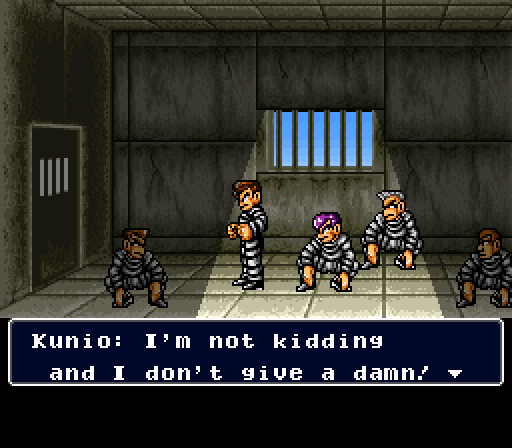
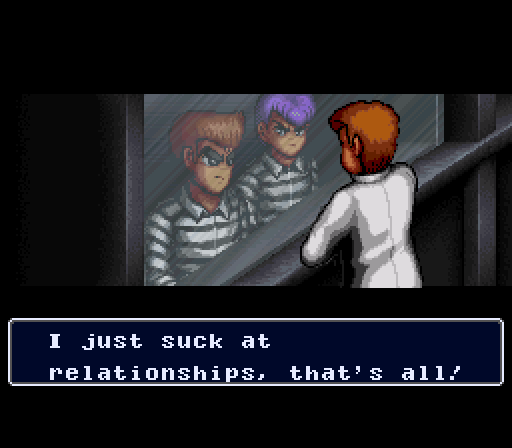
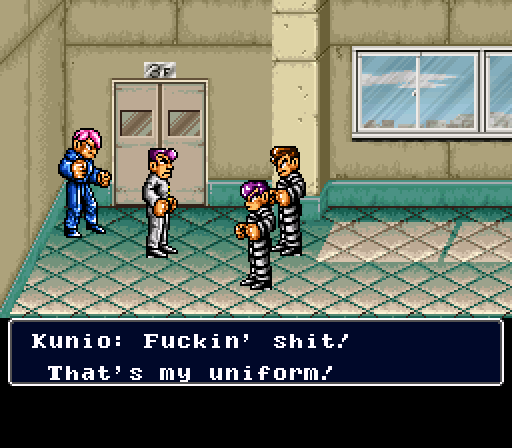
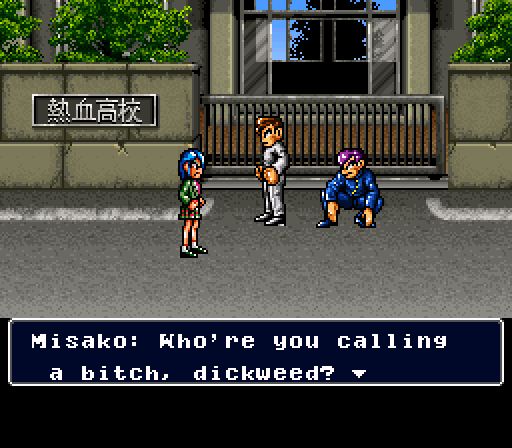
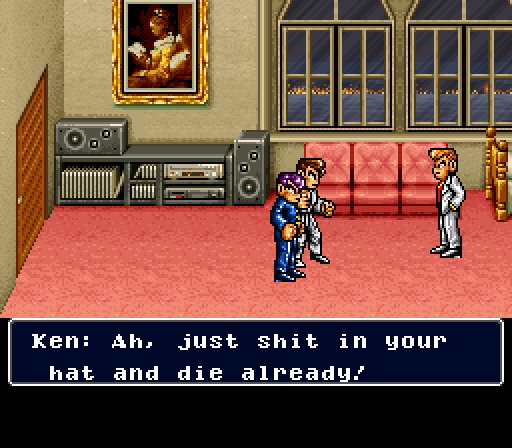
At any rate, while the game's story and dialogue can be entertaining, the combat itself can be mildly repetitive in the usual manner for brawlers of this era. That said, there are some circumstances where the game tries to stretch its imagination muscles once or twice, like the inclusion of hanging hooks that the player can grab onto and kick enemies from, or the occasional death trap in the way of a pier off Tokyo harbor or a collapsing bridge. These occasions where you can defeat an enemy instantly through a "ring out" sort of kill are more reminiscent of Double Dragon, but their relative scarcity is probably due to wanting the game to feel more realistic to befit its crime thriller plot. That said, you do fight on top of a Ferris wheel at one point, so I can't help but feel Kunio-tachi no Banka might've benefited if it had gone off the reservation more frequently. The fun of an eccentric brawler like Double Dragon is that you're never quite sure where you'll find yourself next, or who you'll end up fighting.
Anyway, Kunio will knock my lights out if I dawdle on the science any longer, so with that in mind it's time to process Shin Nekketsu Kouha Kunio-kun: Kunio-tachi no Banka through the equally hot-blooded P.O.G.S. system:
- Preservation: In some regards, the more realistically proportioned sprites and excellent background art raises the game from the cartoonish hijinks of River City Ransom and those block-headed sprites. On the other hand, I feel like River City Ransom's distinctive and simple look has probably aged better overall, as evidenced by the fact that the modern era Kunio-kun games like River City: Tokyo Rumble have returned to it. Likewise, the various mechanical eccentricities of RCR, especially in the way you earn money and spend it in various ways, would certainly appeal more to today's audience than the solid if unexciting street brawling and special moves of Kunio-tachi no Banka. It doesn't really have any big notable flaws, but there might be a reason more people haven't heard of this game, beyond the language barrier. 3.
- Originality: The game can be original with its mechanics on occasion, and I'll refer back to what I said earlier about hanging off ceiling fixtures and taking breaks to ride roller coasters, but for the most part it feels like a straightforward Double Dragon brawler. Definitely more to the combat than your Final Fights or Streets of Rage, but just barely. However, I will give the game extra credit for going full hog on its narrative aspirations, setting itself up as a dramatic thriller with a lot of back and forth and sudden twists. People tragically laying out their backstories while dying, stuff like that. 3.
- Gameplay: In addition to a solid selection of fighting moves and opponents to take on, the game is also elevated by the fact you have four characters to choose from. This means you can switch out an injured character and keep on fighting with one of your back-ups, or use characters you're less comofortable with for small fry and leave your heavy-hitters in decent condition for the upcoming boss. It's a little bit of a shame that the female characters have a few techniques they're not allowed to use, with no extras to make up for it, so they're objectively weaker characters to use - there's something about slapping the shit out of goons that never gets old, nor does stomping on their nuts right after. I am going to dock a point for those motorcycle sections though; nice idea, but really lackluster execution. 3.
- Style: The style section is normally where I'd rate the game's graphics and music, which are both fine, but instead I'm dedicating this spot to the game's script, which I can only assume was localized to suit the over-the-top delivery of the original Japanese. This game is entertaining as hell because of its dialogue, which is definitely rare for a brawler, and I'd take this game's expletive-laden interjections over a million "BARF!"s. 4.
Total: 13.
Other Images:
The Nominee: Squaresoft's Final Fantasy IV
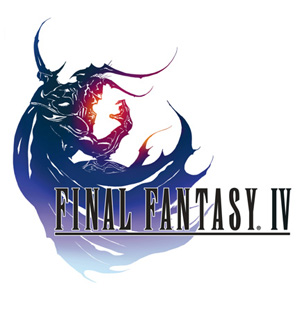
I was dreading this one. If you're just joining this feature, the "Nominee" pick is for a game I'm already familiar enough with to pass judgement, as opposed to the "Candidate" which required a full playthrough before I could consider its merits. Often, these Nominees are obscure favorites of mine that I'm happy to yammer on about in the hopes of diverting a number of retro game fans towards an overlooked classic. However, Final Fantasy IV is one of those games that probably needs no such proselytizing; you either know what this game is, or have played it as often as I have.
Final Fantasy IV, or Final Fantasy II as it was erroneously renamed for its North American release to side-step the thorny issue of two missing localizations, follows the adventures of Cecil, a knight (formerly) in the service of the Kingdom of Baron (which has a King and not a Baron, confusingly). He and his friend Kain have been having doubts about their tyrannical monarch, and being tricked into torching a village of reclusive summoners is the straw that finally breaks the camel's back. Cecil splits from the kingdom with the village's sole survivor in tow, eventually joining a resistance of sorts with citizens (usually monarchs themselves) from neighboring countries with a bone to pick with Baron, and starts down the path of redemption by protecting the world's McGuffin crystals from a mysterious man in black armor. The game brings back the focus on characterization as well as story, which was a narrative construct that appeared briefly in Final Fantasy II (the real one) before vanishing again in favor of an interchangeable gaggle of "Onion Knights" in Final Fantasy III, and rather than determining the player's party through a surfeit of members that the player could pick and choose from as they wished, characters would drop in and out of the group as the situation demanded. It was a bit more dynamic and plot-influenced than Final Fantasy had been or will be again, at least until Final Fantasy XV with its unchanging four-person team (barring the few occasions when a party member left just long enough to fill a DLC chapter with their adventures).
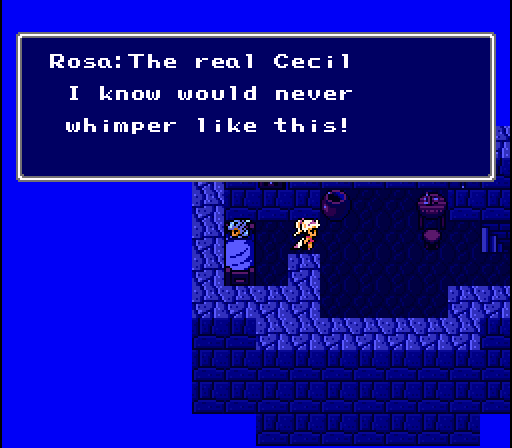
Final Fantasy IV's perhaps the most straightforward the Final Fantasy franchise has ever been. There's very little in the way of convoluted character progression systems to keep track of and the story's simple enough and filled with traditional elements of fantasy fiction like redemption, and demons, and mysterious antagonists, and a race to protect the world from annihilation. It's all done in a much more elaborate and narratively-rich way than the threadbare plot of Final Fantasy I or the confusing keyword-laden morass that was Final Fantasy II, and perhaps the start of Final Fantasy as this story-driven enterprise that puts its presentation and mechanics at the forefront. I generally consider Final Fantasy IV to be the A Link to the Past of Final Fantasy games, and not just because the two were released the same year: if you wanted to give someone an idea of the Final Fantasy franchise in an easily digestible microcosm, or simply start them on the franchise with a solid entry that wouldn't break their minds the first time they tried to make a character stronger, Final Fantasy IV would perhaps be the ideal choice. It has a self-recriminating hero that gradually tries to better himself with the help of his allies, it has a whole bunch of nonsense about crystals and the lifeforce of the planet, it heavily features the dang moon as a major location, it doesn't exactly establish chocobos and moogles but features plenty of both, it has the best Cid of the whole series, and unlike most Final Fantasy games its dramatic turns can be pretty darn affecting. Or at least they were when I last played it.
It's all well and good talking up one of the best known RPGs on the SNES for a few effusive paragraphs, redundantly preaching to the choir, but a true test of its mettle requires encountering the figurative four fiends that make up the P.O.G.S. system:
- Preservation: Of the SNES Final Fantasies, I might argue that Final Fantasy IV has the least to offer a modern audience. Final Fantasy has sort of become the de facto representation of what this genre is and what it can do, mostly because of the wild mainstream success of Final Fantasy VII but also because the series is constantly trying to reinvent itself with its divergent systems and stories. Final Fantasy V had a modified version of the critically-acclaimed Job system, while Final Fantasy VI had all sorts of experiments with scenario-based narratives, with a completely open second half. Conversely, that makes Final Fantasy IV a perfect launching point for those looking to get into the series: it's some solid, moderately challenging 16-bit RPG action without a whole lot of convoluted or antiquated systems to contend with. 4.
- Originality: Final Fantasy IV isn't particularly novel in pure gameplay terms. It builds on its previous trilogy, sticking to a rigid class system for its characters - with the exception of the protagonist's dramatic (but not particularly different) class change, everyone starts out in the combat role they'll inhabit for the rest of the game - with a simple progression system that awards new skills and spells for certain level milestones. Narratively, it's when the franchise really started hitting its stride in telling these twisting epics, integrating memorable cutscene-like battles for the sake of a story beat. It's hard to argue for how original that is, given how many SNES RPGs would use it as a launching point, but I'd argue that being as iconic as it is deserves some recognition in this category. 4.
- Gameplay: Even without the Job system and all the other bizarre character progression systems Final Fantasy has spawned over the years, Final Fantasy IV still represents a platonic ideal for the franchise: one with few flaws, and a level of ambition that is predicated on what they could do with the bounties of the 16-bit era rather than too much in the way of thinking outside the box. Rather, it's the box itself, a standard that Squaresoft built for themselves which they could try to surpass with the following games, letting them be the ones to attempt to outdo their older brother with wild gameplay notions and gimmicks. There are those that still argue that the high bar FF4 set for the franchise has yet to be conquered. 5.
- Style: Squaresoft has always been an RPG developer that cares about aesthetic, and the jump to 16-bit greatly expanded what they could do with their flagship franchise's look. The distinctive character sprites and portraits are more in line with Yoshitaka Amano's wonderfully idiosyncratic concept art, and the monster sprites, backgrounds and animations all get a visual boost. The Nobuo Uematsu soundtrack is, of course, another highlight, with boss tracks like Battle with the Four Fiends and Zeromus, or the iconic march of The Red Wings, being particular stand outs. 5.
Total: 18.
Other Images:














